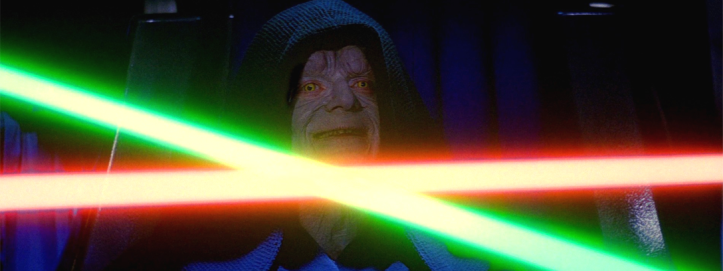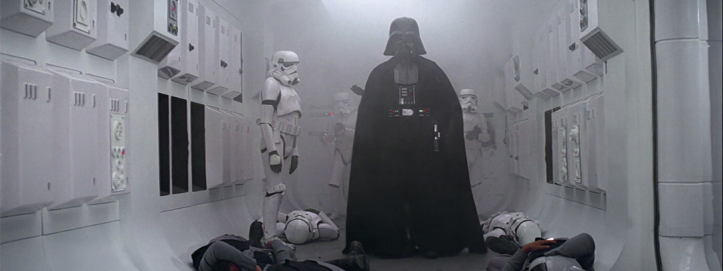I’m a second generation Star Wars fan. My father was 10 when Star Wars (later subtitled A New Hope, the title I’ll use from here on out) hit theaters. By the time I was his age, that film and its two sequels, The Empire Strikes Back and Return of the Jedi, had just been re-released in theaters in their special edition formats. Thanks to my dad’s well-stored collection, I had access to his old Star Wars toys and books, and I was able to add my own toys and books into the mix. I still have the original trilogy on VHS (in both the special edition and pre-special edition formats, to boot), the DVDs for the original trilogy and the prequel trilogy that began in 1999, and the Blu-ray collection that brought the entire saga into one collection.
Or, the entire saga until now.
Ten years after what many of us assumed would be the last Star Wars film, Revenge of the Sith, hit theaters, audiences get to return to that galaxy far, far away a long time ago. Star Wars: The Force Awakens marks the beginning of a new series of Star Wars films, currently comprised of a new trilogy and standalone films that will be released on a yearly basis. Even though Star Wars has explored the galaxy far beyond the events of Episodes I-VI, we’re about to get some new stories on film, the series’ native format.
This makes the idea of ranking these films seem newly daunting. There are exceptions, obviously, but ranked Star Wars lists in the last decade tend to break down between two choices for the top two spots, two choices for the middle, and two for the bottom. The new Star Wars films will inevitably shake things up, and will likely lack the consistency that these lists have taken in the last decade. That’s good. We may actually have a new contender for the best Star Wars film of all time in the foreseeable future.
With The Force Awakens finally kicking off this new run of Star Wars films, Out Ranked looks at every major film in the Star Wars universe.

7. Attack of the Clones
While The Phantom Menace was a box office smash when released in 1999, it didn’t earn nearly the same love from fans of the Star Wars series that the original trilogy earned. Attack of the Clones is, in many ways, Lucas giving fans what he thinks they want. How mistaken he was. While avoiding some of The Phantom Menace‘s numerous issues, including a far more intriguing opening act, Lucas also engages in unnecessary fan service. For example, Boba Fett’s a popular character, so why not show him as a child – who happens to be tied to the Clone Army? Additionally, Lucas’ years-long love of digital technology (first seen in the 1997 special editions) reached a peak in poor judgment. Like the films that precede it, the CGI has aged more rapidly than practical effects, but Lucas’ increased use of blue screen technology and his insistence on switching from film to digital make the film look visually unappealing regularly. And then, there’s the romance. Lucas has never been the best at writing dialogue, but here he shows that he has absolutely no clue how to write a good romantic pair. It doesn’t help that Hayden Christensen’s Anakin is a complete creep, or that Christensen and Portman share no chemistry whatsoever. But considering exactly how important this specific relationship is, not only to the prequels but to the entire series, it’s telling how unbearable the scenes of Anakin and Padmé’s courtship are to watch. Outside of the opening sequence, only a few portions of the film even work: Obi-Wan’s search for those wishing to assassinate Padmé, and Anakin’s scene with his mother, showing the first real glimpse of the darkness lurking within.

6. The Phantom Menace
Did The Phantom Menace arrive with perhaps too much fan anticipation? Possibly. Regardless, The Phantom Menace is a frustrating film. The most interesting characters that are new to the universe are dispatched before the end credits. The conflict involves an overly aggressive trade dispute. Darth Vader is revealed to be the least charismatic nine year old in the galaxy. Several characters across the galaxy are connected to racial stereotypes. Jar Jar Binks comes into existence. Midi-chlorians. The largest problems with the film, and the prequel trilogy as a whole, is that George Lucas was able to do whatever he wanted with these films. The original Star Wars was a studio production (all sequels are owned by Lucasfilm outright), and it was an untested property, so there were limits to what Lucas could do. The sequels had outside directors and writers. By the time The Phantom Menace came around, Lucas hadn’t properly directed or written a film on his own in 22 years. And while Lucas has ideas that could very well work, they need people who can direct and especially write better. That being said, The Phantom Menace does provide the series with at least one element that tops any of the other films: the showdown with Darth Maul. With the series now set in a time where the Jedi are numerous, it makes sense that the fighting would be more complex. Here, we have a fight that is strongly choreographed without looking overly staged. It’s a rare thrilling moment in an otherwise humdrum film.

5. Return of the Jedi
It’s not that the original trilogy went out with a whimper, necessarily. It’s more that Return of the Jedi fails to match the greatness of its predecessors. Individual sections of the film work – namely the opening act in Jabba’s palace and Luke’s confrontation with Vader and Emperor Palpatine. Palpatine, for the record, is the film’s greatest contribution to the series; even though he technically appears in The Empire Strikes Back (and in recent versions of the film has been replaced by match Jedi and the prequels), Ian McDiarmid brings a snarling cruelty that completely sells Vader’s positioning as his subordinate. But the decision to focus on a second Death Star, even if it’s larger and incomplete, feels derivative of A New Hope at a point where the series only consisted of three films. The inclusion of the Ewoks isn’t necessarily bad on its own, but it does shift the series into more kid-friendly territory than the first film, which had already pivoted to darker themes with The Empire Strikes Back. Again, Return of the Jedi isn’t a bad film. But it is uneven in a way that its predecessors weren’t, and as what for years was the conclusion to a trilogy (and then a larger series), it lacks some of the muscle of its predecessors.

4. Revenge of the Sith
Shocking placement? Maybe. Revenge of the Sith is an odd inversion of Return of the Jedi. Where that film suffers compared to the two films that precede it, Revenge of the Sith benefits in part from being a giant step forward for the prequel trilogy. The most significant factor in this is that it finally shows Anakin Skywalker’s turn to the Dark Side, something only briefly hinted at in Attack of the Clones. Palpatine’s machinations in the previous films were apparent, but here, they’re brazenly on display, and Ian McDiarmid chews every scene he’s in like it’s part of his last meal. While Christensen is still not a great choice for Anakin, he’s largely improved here as his desire to protect Padmé morphs into a thirst for control. While Ewan McGregor’s take on Obi-Wan Kenobi is generally one of the better elements of the prequels as a whole, his final outburst of emotion during the climactic battle with the newly-turned Darth Vader is the acting high point of this trilogy. And while Lucas still doesn’t have a great relationship with dialogue as a whole, there’s a momentum to the story that makes it work better. Mostly. (He still can’t write romance.) On top of that, his direction seems more confident, and the technology used to create the universe is a significant improvement over the special editions of the original trilogy and the two other prequels. It’s still not Star Wars at its best, but Lucas was able to end his run on the series with a dark but relatively high note.

3. The Force Awakens
With future viewings, this placement could very well rise. At the risk of sounding like a fanboy, though, The Force Awakens is the best thing to happen to Star Wars in 35 years. With a largely (but not completely) new creative team in place, The Force Awakens has the unenviable task of pushing the film series into the future for the first time since 1983. On top of that, it also has to reignite a fanbase frequently let down by the prequel trilogy. Under director/co-writer J.J. Abrams, who brings along Empire and Jedi writer Lawrence Kasdan, The Force Awakens more than succeeds. It successfully weaves returning characters in with a slew of new ones, and within the span of a few hours, the series has new characters who are unique and unforgettable. Abrams wisely focuses more on action than the prequels did, but makes the breaks between action scenes count for developing Rey, Finn, Poe Dameron and Kylo Ren, our lead characters going forward. There’s plenty of humor, and a surprising amount of heart. And while the film feels in many ways like it’s recreating A New Hope, with elements of The Empire Strikes Back thrown in, the film’s final scene hints at a new direction going forward (and is the series’ strongest final scene to date, period).

2. A New Hope
The one that started it all. A New Hope is the perfect introduction to the Star Wars universe. It’s not a perfect film, but it’s easily the most self-contained entry in the series, while also hinting at a much larger galaxy that we’re still exploring nearly four decades later. As Luke Skywalker begins to learn the ways of the Force from Obi-Wan, there’s a genuine sense of wonder. There’s also dread in every scene featuring Darth Vader, used here in tandem with Grand Moff Tarkin. The cantina scene hints at the diversity of the galaxy, while the destruction of Alderaan shows the depths of the Empire’s evil. Most importantly, there’s a blend of action, romance, comedy and tragedy that makes the film just as watchable today as it was in 1977. Just remember: in spite of any rumors to the contrary, Han shot first.

1. The Empire Strikes Back
When Star Wars destroyed records in 1977, the series could have easily churned out a sequel that duplicated what came before. Instead, after drafting the story, George Lucas handed the reins of the sequel over to director Irvin Kershner and screenwriters Leigh Brackett and Lawrence Kasdan. The result is a film that is wittier, edgier, and immensely darker. “Darker” doesn’t begin to describe The Empire Strikes Back, really. That title, though, is punishingly accurate. Luke, Han and Leia face daunting challenge after daunting challenge as Darth Vader and the Empire hunt them down. It’s impossible to single out a standout scene from this film, because The Empire Strikes Back is filled with standout scenes. From a wampa’s attack on Luke and the battle of Hoth, to Luke’s training under Yoda (never better than he is here) and Han and Leia’s run from the Empire. Everything leads up to the events on Bespin, where Han is frozen in carbonite, C-3PO is dismembered, and Luke’s first face-to-face confrontation with Darth Vader leads to one of the biggest twists in cinematic history (and remember, Luke’s response is initially to commit suicide by falling). While the film ends with a glimmer of hope, there isn’t a happy ending to this film. There’s no grand battle. There’s just a chance for our heroes to finally escape, where they can recover.

